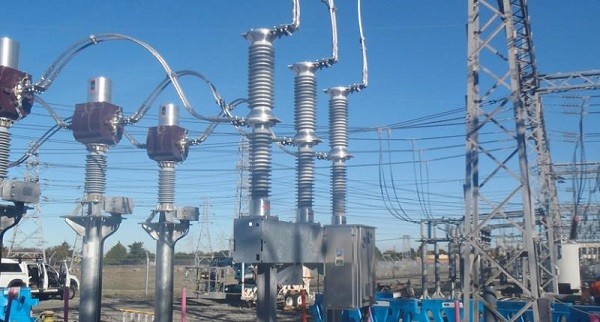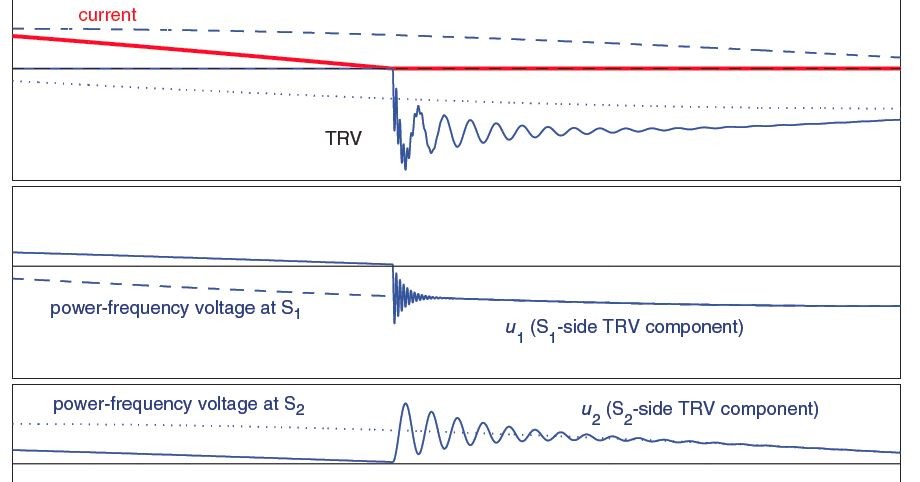
What s out of phase switching phenomenon:
Out-of-phase switching conditions occur for circuit breakers at a coupling of two network parts of equal operating voltages, the equivalent sources of which have different phase angles, partly or entirely 180◦ out of phase.
A difference in the phase-angle of the rotating vectors representing the source voltages causes out-of-phase currents across the connection, which must be interrupted by a circuit-breaker at either side of the connection.
As regards the TRV, the specialty of this switching duty is the presence of active sources on both sides of the circuit-breaker. This is explained in Figure 1 with sources S1 and S2.

Considering the fault-switching duties discussed before, in all cases the load-side TRV component decays to zero. In the out-of-phase situation, however, the S2-side TRV component will decay to the power-frequency RV of the S2-side source. This is outlined in Figure 2 where the voltage phase difference between both sources is assumed to be 90◦ and the short circuit reactants are considered equal.
As a result, the out-of-phase switching duty is characterized by a very high TRV peak with a moderate RRRV and a moderate current. Because the TRV of the out-of-phase test duty shows the highest peak value of all switching duties, it is often used as a reference for other special switching conditions, such as clearing long-line faults or faults on series- compensated lines.

Two cases in which out-of-phase conditions may occur are shown in Figure 3.One case occurs when a generator is accidentally switched by circuit breaker on to the network at the wrong phase angle (left schematic ). The other case occurs when different parts of a transmission network lose their synchronism, e.g. due to a short-circuit somewhere in the network (right schematic). In both cases, an out-of-phase current will flow in the networks and will have to be interrupted by the circuit breaker.

Now explain each case in details:
1-Switching between Generator and System:
Switching between the generator and power system may take place at the high voltage side or at the medium voltage side of the transformer when a step-up transformer is applied. Switching may be faced during system disturbances or during tripping of the power plant, but can also happen during synchronization and mis-synchronization.
The severity of the out-of-phase condition depends on the out-of-phase angle between the generator and network as well as on the excitation of the generator rotor. Usually the excitation control will reduce the rotor field as fast as possible. Power plants are equipped with out-of-step protection, synchro-check equipment and synchronization equipment, among others.
we can see this lay out in Figure 4:

2-Switching between Two Systems:
Switching between two power systems typically occurs in situations with power unbalance and system instability. Examples refer to large system disturbances, situations during system restoration, and due to the mis-operation of protection systems.
The more important transmission lines may be equipped with an out-of-phase blocking in their protection system and/or a special system-wide protection may be applied to prevent separation of the systems under severe out-of-phase conditions.
Conclusions of out-of-phase phenomena:
- The rated out-of-phase currents have been proposed to be 25% of the rated short-circuit current. For economic and statistical reasons, minimum peak values from the TRV analyses have been proposed: a RV of 2.0 p.u. and an overshoot of 25% .
- As system separation goes with cascading tripping of overhead lines and thus an increase of the system impedance, a maximum value of 25% of the rated short circuit current seems to be reasonable, even today. The maximum value of the out-of-phase current is an important parameter for the high voltage circuit breaker capabilities.
- Large disturbances show out-of-phase angles much larger than the 105 degree to 115 degree values associated with the TRV peak values in the standards. This applies both to radial and meshed networks; however, historical events have shown that large out-of-phase angles may occur at the same time as low operating voltages. The combination of a large out-of-phase angle and low operating voltage yields TRV peak values similar to those mentioned in the standards for situations with a relatively low out-of-phase angle and rated voltage (maximum operating voltage).
- Transmission system circuit breakers used to connect or disconnect conventional power plants may be subjected to out-of-phase switching as well. To disconnect power plants during unstable power swings, the same considerations as for system separation are applicable albeit with care for the possibility that a transformer limited fault test condition has to be specified.
- To disconnect power plants due to faulty synchronization, similar conditions and requirements as described for medium voltage generator circuit breakers are applicable, and simulations are necessary to judge whether a design can fulfill the duty. Simulations of such events should include the response time of protection systems, the depression phenomenon of the generator voltage, and the acceleration/deceleration of the rotor to identify whether the out-of-phase current and the TRV after false synchronization of generators cover the conditions prescribed by the user, for instance, 180 degree.
References :
- Live Tank Circuit Breakers Application Guide ,ABB
- Switching Equipment book ,CIGRE
- Switching in Electrical Transmission and Distribution Systems book ,René Smeets • Lou van der Sluis ,Mirsad Kapetanovi • David Peelo ,Anton Janssen




Thanks for this article. Just 1 remark: the link « RRRV » is pointing another article about GCBs, which I guess is unexpected (I assume it shall point to an article about Rate of Rise of the Recovery Voltage)
Thank you for your comment.
For out of phase and RRRV in Generator Circuit Breaker please see GCB category:
https://switchgearcontent.com/category/generator-circuit-breaker/
Good analysis of the Circuit breaker specification required for very rare case.
It is better to have the Circuit breakers for this specification even the incidence are few across the Power Transmission.
However we have seen no. of monitoring and protection relays being used to sense the “Healthy condition” ** before sending closing commands to Circuit breaker.
With the advanced electronics and communication, one can ensure the closing commands to Circuit breaker only after ensurring healthy condition.
** Healthy conditions are Phase sequence, Phase angle, Phase voltage
Thank you for your comment.
Yes, I agree with you about Check the condition of the circuit breakers and the network in which the circuit breaker is installed.
In standard IEC61850 these items are considered and you can find a lot of content for circuit breaker conditions in the network on the switchgear content website.
Control switching technology also can help with this issue.